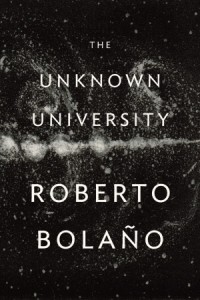25 Points: The Unknown University
 The Unknown University
The Unknown University
by Roberto Bolaño
New Directions, 2013
766 pages / $39.95 buy from Amazon
1. I’ve a strange attachment to Roberto Bolaño. One of coincidence and timing and love.
2. The Savage Detectives came out in the US six years ago, the same week I decided that—yeah, dammit—I was going to do an MFA.
3. I finished my MFA not too long ago (May-ish), just as the Bolaño Library seems to have exhausted its basement of posthumous manuscripts with The Unknown University, “a deluxe, bilingual edition of all the poems of the great Roberto Bolaño.” (Or so says the flap).
4. The Unknown University, really, reads more as a manuscript of notebooks. Poems incorporate drawings, caesuras become page-breaks, forms change again and again and again. At first, it reminded me of Jack Kerouac’s Mexico City Blues, in which every page of the book was in fact a typed page of a notebook’s musings. This feels like that, but rewritten from notebooks to computer and revised.
5. It’s 700+ pages and irresistible to a Bolañophile like me. A short story that recently ran in the New Yorker appears (“Mexican Manifesto”), as does the whole of the novel Antwerp, albeit in somewhat different form (and under the title “People Walking Away”). I didn’t do a full index-to-index comparison, but it also seems the whole of 2008’s The Romantic Dogs appears in a scattering throughout Part Three.
6. Despite these inclusions, though, The Unknown University isn’t a collection of previously-published books, like other “complete” collections can tend to be. (Just above my Bolaño shelf at home are the Collected Lydia Davis and Amy Hempel, which are exactly that).
7. Some such collections, like Jack Gilbert’s or Richard Hugo’s, have a section of “uncollected” pieces that follow the chronological reprintings. The Unknown University is sort of like one big “uncollected” section, but one that the author took the time to fashion into something that can live alone.
8. According to the note from the heirs: “The present edition corresponds exactly to the manuscript we found (with only a few minimal corrections taken off of his computer). Roberto himself dates it to 1993.”
9. These are early writings. An author’s note lists the completion of some sections as early as the 1970’s, when Bolaño was just Roberto, one of the boy-poet idealists he takes so often as subject in his fiction. In several poems he makes reference to his age (typically 26 or 27), which would have been around 1979-80.
10. One could imagine The Unknown University as the texts Bolaño wrote during the time of his writerly maturation, for what many now is the MFA. READ MORE >
August 22nd, 2013 / 11:00 am
